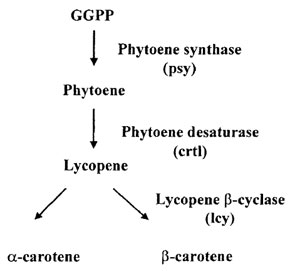For the developing world
Manipulation of the carotenoid pathway in rice
The nature of the challenges faced in manipulating plant secondary metabolites is well illustrated through the attempts that have been made to produce carotenoids in rice plants. A simplified version of the pathways leading to the synthesis of the carotenoids principally found in food plants is shown in Fig. 7.2.
Immature rice endosperm is capable of synthesising the early pathway intermediate geranylgeranyl diphosphate (GGDP). Four plant genes corresponding to the enzymes phytoene synthase (psy) (1), phytoene desaturase (2), zeta carotene desaturase (3) and lycopene cyclase (crt) (4) are required. Enzyme (1) was obtained from the daffodil (Narcissus pseudonarcissus), (2) from a bacterium Erwinia uredovora – which is capable of achieving steps (2) and (3) from the single enzyme, and (4) from the daffodil.
The genes need to be expressed in a tissue-specific manner through the insertion of specific promoters. This has been achieved in rice through the use of the daffodil psy gene [19]. In rice the daffodil psy cDNA insertion is under the control of an endosperm-specific promoter. The choice of promoter will very much affect the timing and tissue-specific expression of a gene.
The controversy over the use of advanced technologies for producing sustainable food in the developing world has been addressed by the developers of modified rice. They have in effect waived all intellectual property rights for exploitation of the technologies in the developing world, and are actively involved in assisting the International Rice Research Institute to breed stable and agronomically successful lines for use in vitamin A-deficient areas.





